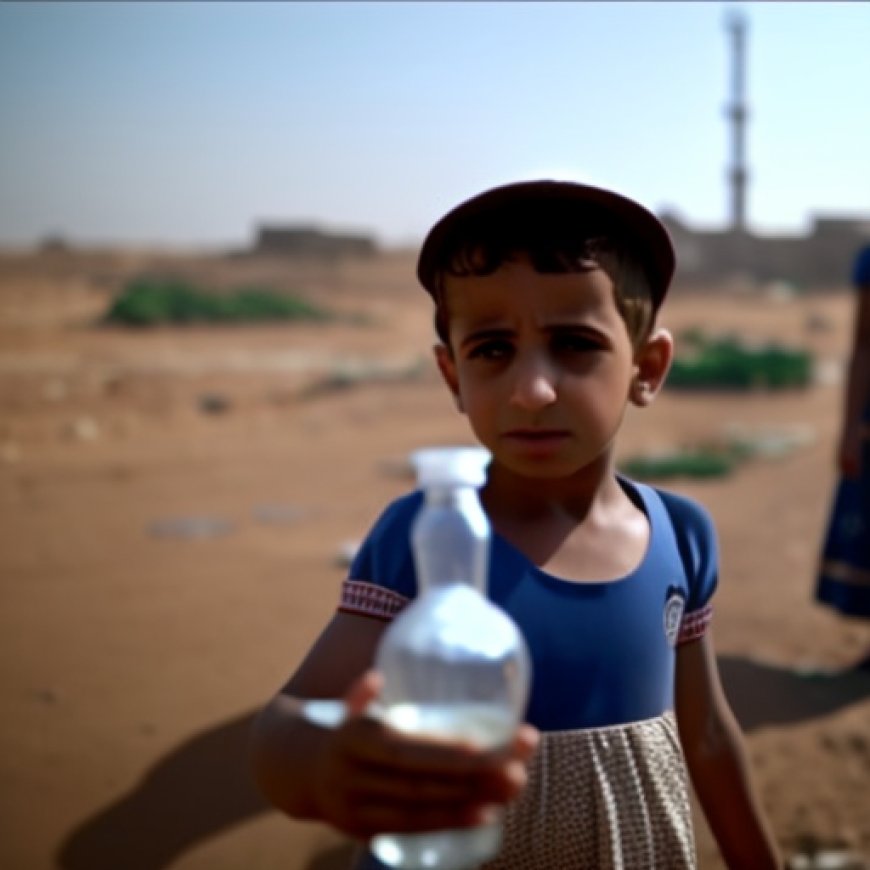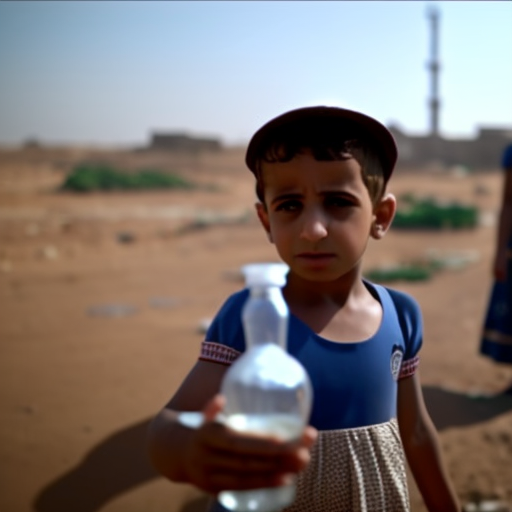‘Barely a drop to drink’: children in the Gaza Strip do not access 90 per cent of their normal water use
'Barely a drop to drink': children in the Gaza Strip do not access 90 per cent of their normal water use UNICEF


Displaced Children in Gaza Strip Facing Severe Water Shortages
AMMAN, 20 December 2023 – According to estimates from UNICEF, recently displaced children in the southern Gaza Strip are only accessing 1.5 to 2 litres of water per day, which is well below the recommended requirements for survival.
Humanitarian standards state that the minimum amount of water needed in an emergency is 15 litres per person, which includes water for drinking, washing, and cooking. For survival alone, the estimated minimum is 3 litres per day.
Critical Situation in Rafah
Hundreds of thousands of internally displaced people, half of whom are children, have arrived in Rafah since early December and are in desperate need of food, water, shelter, medicines, and protection. The water and sanitation systems in the city are in an extremely critical state as demand continues to rise. The resumption of hostilities, along with a lack of power supply, fuel shortages, restricted access, and infrastructure damage, has resulted in at least 50% of water, sanitation, and hygiene (WASH) facilities being damaged or destroyed.
Impact on Children
The impact of the water shortage is particularly dramatic for children who are more susceptible to dehydration, diarrhea, disease, and malnutrition. These factors pose a threat to their survival. Concerns about waterborne diseases such as cholera and chronic diarrhea are heightened due to the lack of safe water, especially after recent rains and flooding. Officials have already recorded almost 20 times the monthly average of reported cases of diarrhea among children under the age of 5. There have also been increases in cases of scabies, lice, chicken pox, skin rashes, and more than 160,000 cases of acute respiratory infection.
UNICEF’s Response
UNICEF, in partnership with other organizations, is providing assistance to address the water crisis. They have supplied fuel to operate wells, desalination plants, water trucking, and waste and sewage management. They have also distributed bottled water, water containers, jerry cans, family hygiene kits, menstrual health and hygiene products, and bars of soap. Additionally, UNICEF has reached over 189,000 people with hygiene supplies and more than 400,000 people with hygiene and sanitation services. Despite challenging access conditions, they were able to reach the northern Gaza Strip during a humanitarian pause and distribute 260,000 litres of water and 10,000 hygiene kits.
Challenges and Restrictions
However, there are challenges in providing sufficient aid. Generators and construction materials needed for repairs are available at the Rafah border crossing but are unable to enter Gaza due to access restrictions. These supplies are necessary to restore minimum water and sanitation services critical for the survival of the people and children.
Call for Humanitarian Access
UNICEF continues to call for rapid, safe, and unimpeded humanitarian access to all children and families in need. They emphasize the importance of restoring and rehabilitating existing infrastructure to address the water and sanitation needs in the Gaza Strip. They also urge all parties to adhere to their international legal responsibilities to protect water and sanitation facilities and workers responsible for maintenance and repair.
SDGs, Targets, and Indicators
| SDGs | Targets | Indicators |
|---|---|---|
| SDG 6: Clean Water and Sanitation | 6.1 By 2030, achieve universal and equitable access to safe and affordable drinking water for all | – Access to only 1.5 to 2 liters of water per day, well below the recommended requirements for survival – Minimum amount of water needed in an emergency is 15 liters, including water for drinking, washing, and cooking – Estimated minimum of 3 liters per day for survival alone |
| SDG 3: Good Health and Well-being | 3.3 By 2030, end the epidemics of AIDS, tuberculosis, malaria, and neglected tropical diseases and combat hepatitis, water-borne diseases, and other communicable diseases | – Concerns of waterborne diseases such as cholera and chronic diarrhea due to lack of safe water – Increase in reported cases of diarrhea among children under the age of 5 – Increase in cases of scabies, lice, chicken pox, skin rashes, and acute respiratory infection |
| SDG 5: Gender Equality | 5.1 End all forms of discrimination against all women and girls everywhere | – Impact on women and girls due to reduced hygiene options and lack of showers |
| SDG 11: Sustainable Cities and Communities | 11.1 By 2030, ensure access for all to adequate, safe, and affordable housing and basic services and upgrade slums | – Long queues for limited toilets in shelters, leading to alternative coping strategies like open defecation |
| SDG 17: Partnerships for the Goals | 17.17 Encourage and promote effective public, public-private, and civil society partnerships, building on the experience and resourcing strategies of partnerships | – UNICEF providing fuel, water trucking, waste and sewage management, bottled water, hygiene kits, and sanitation services – Call for rapid, safe, and unimpeded humanitarian access to address water and sanitation needs |
Behold! This splendid article springs forth from the wellspring of knowledge, shaped by a wondrous proprietary AI technology that delved into a vast ocean of data, illuminating the path towards the Sustainable Development Goals. Remember that all rights are reserved by SDG Investors LLC, empowering us to champion progress together.
Source: unicef.org

Join us, as fellow seekers of change, on a transformative journey at https://sdgtalks.ai/welcome, where you can become a member and actively contribute to shaping a brighter future.







